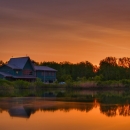About Us
Cedar Point National Wildlife Refuge was established in 1964 as an inviolate sanctuary, or for any other management purpose, for migratory birds. The 2,445 acre marsh was donated to the North American Wildlife Foundation by the Cedar Point Shooting Club, a hunt club that had owned Cedar Point marsh since 1882. The foundation sold the marsh to the U.S. Fish and Wildlife Service for $1 with the provision that it is not used as a public park, campground or picnic area.
The area that is now the refuge is part of what was the Great Black Swamp. The swamp covered approximately 1,500 square miles and was a vast network of habitats consisting of forests, wetlands and grasslands. It was first used by the many Indigenous people of the area. Hunting and fishing camps were located on the gravel point when the lake levels were low. The first documented structure built in the area was by a fur trader who lived in a cabin on the point. When the hunt club purchased the property, their hunt lodge was also built on the point. The club was owned by wealthy industrialists from Cleveland, Ohio. Former Secretary of Treasury George Humphrey's guest President Dwight D. Eisenhower hunted at the marsh twice during his presidency.
An additional donation by the Lamb family brought the total area of the refuge to 2,616 acres which contain three impounded wetlands. The largest unit is 1,444 acres and one of the largest remaining contiguous wetlands in the western basin of Lake Erie. This unit is managed by a pump system and a water control structure that includes a fish passage fish passage
Fish passage is the ability of fish or other aquatic species to move freely throughout their life to find food, reproduce, and complete their natural migration cycles. Millions of barriers to fish passage across the country are fragmenting habitat and leading to species declines. The U.S. Fish and Wildlife Service's National Fish Passage Program is working to reconnect watersheds to benefit both wildlife and people.
Learn more about fish passage system. It has diverse vegetation and contains the largest wild rice population in Ohio. The refuge includes two rare cottonwood dune forest communities next to Lake Erie which provide critical habitat for migrating songbirds.
Our Mission
The mission of the National Wildlife Refuge System is to administer a national network of lands and waters for the conservation, management and, where appropriate, restoration of the fish, wildlife and plant resources and their habitats within the United States for the benefit of present and future generations of Americans.
Every national wildlife refuge national wildlife refuge
A national wildlife refuge is typically a contiguous area of land and water managed by the U.S. Fish and Wildlife Service for the conservation and, where appropriate, restoration of fish, wildlife and plant resources and their habitats for the benefit of present and future generations of Americans.
Learn more about national wildlife refuge was created for a special purpose. Some were created to protect migratory birds, others to protect threatened or endangered species or unique habitats, while others fulfill another special purpose. All activities allowed on refuges must be evaluated to make sure each activity will not conflict with the reason the refuge was founded.
The purpose of Cedar Point National Wildlife Refuge is to serve as an inviolate sanctuary for migratory birds. The refuge must be at least partially closed to migratory bird hunting to allow birds a place of refuge and protection where they cannot be harmed.
Our History
1964 - The refuge was established under the authority of the Migratory Bird Conservation Act as an inviolate sanctuary, or for any other management purpose, for migratory birds.
Other Facilities in this Complex
This refuge is managed along with Ottawa National Wildlife Refuge and West Sister Island National Wildlife Refuge. Most of the wading birds, great blue herons, great egrets and double-crested cormorants that you see in the marshes nest on West Sister Island. These birds must travel nine miles to shore to feed in the shallow waters of the marshes.

